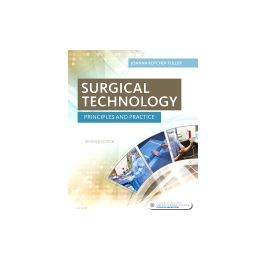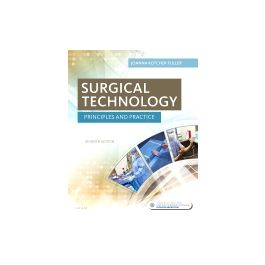This is completed downloadable of Test Bank for Surgical Technology 7th Edition by Fuller

Product Details:
- ISBN-10 : 0323394736
- ISBN-13 : 978-0323394734
- Author: Joanna Kotcher
Learn to deliver the best patient care before, during, and after surgery with Surgical Technology: Principles and Practice, 7th Edition. Within its pages you’ll find comprehensive coverage of all the updated AST Core Curriculum components ― including all aspects of health care sciences; technological sciences; patient care concepts; preoperative, intraoperative, and postoperative care; surgical procedures; and professional practice. But what you won’t find in any other surg tech book is an incredibly reader-friendly approach featuring conversational, mentor-like guidance and loads of full-color pictures and illustrations. You’ll also have an abundance of helpful learning features at your disposal ― like case studies, review questions, and online learning activities ― that will help you easily master important concepts and apply that learning to professional practice. No other surgical technology text better prepares you for the challenges of professional practice!
- Comprehensive coverage addresses all areas of the AST Core Curriculum for Surgical Technology.
- Reader-friendly writing style and organization utilizes a mentoring approach to present content within the building blocks of fundamentals, aseptic technique, the role and function of the surgical technologist, and surgical procedures.
- Consistent chapter format breaks down each surgical procedure in an easy-to-understand way making it easy for students to comprehend the key elements of more than 70 procedures.
- Experienced author/consulting editor team lends a breadth of experience for a well-rounded view of life in the operating room and multiple perspective focused on quality patient care.
- Over 1,200 full-color illustrations and clinical photos bring concepts and procedures to life.
- Robust practice opportunities include review questions and case studies at the end of each chapter along with crosswords, additional review questions, and surgical practice videos found on the Evolve companion website.
- Learning objectives serve as checkpoints for comprehension and as study tools in preparation for examinations.
- Key terminology appears in boldface and in color within chapter discussions and are defined and cross-referenced to chapters in a back-of-book glossary.
- Key concepts are covered in a bulleted list at the end of each chapter discussion to summarize and rephrase chapter concepts.
- References and bibliographiesprovide a listing of in-text and additional citations of scientific research.
- Pathology appendix summarizes the most commonly seen pathological processes and organizes them by body system.
- Website mentions are highlighted within the text to draw readers’ attention to available videos in the Evolve Resources and suggested websites to visit for additional information on content covered.
- NEW! Content on dynamic topics focus on emerging areas of research and study including the latest equipment and technology, robotics and lasers, advances in orthopedic, cardiovascular, and neurological surgeries, and professionalism.
- NEW! Improved surgical procedures now incorporate pathology, technical points and discussion, as well as information on patient positioning, prepping, draping, incision, instruments, and supplies.
- NEW! Instrument tables showcase relevant instruments and accompanying sizes in an illustrated format.
- NEW! Expanded technique boxes succinctly summarize the key steps within skills or procedures to highlight core competencies.
- NEW! Knowledge and skills review at the beginning of chapters alerts readers to key information and skills incorporated into chapter discussion.
- NEW! Updated artwork and photographs feature the most current supplies and equipment to vividly demonstrate aseptic technique, sterilization and disinfection, surgical instruments, patient positioning, skin preparation, and draping.
Table of Content:
- Part I. Surgical Technology Principles
- 1. The surgical technologist
- Bibliography
- Reference
- 2. Communication teamwork and professionalism
- Bibliography
- 3. Law, documentation, and professional ethics
- References
- Bibliography
- 4. The health care facility
- Section I: The perioperative environment
- Section II: Health care facility departments and functions
- Section III: Health care administration
- Bibliography
- Reference
- 5. The patient
- Reference
- Bibliography
- 6. Diagnostic and assessment procedures
- Bibliography
- 7. Environmental hazards
- References
- Bibliography
- 8. Microbes and the process of infection
- Bibliography
- 9. The principles and practice of aseptic technique
- Bibliography
- 10. Decontamination, sterilization, and disinfection
- Bibliography
- 11. Surgical instruments
- Bibliography
- 12. Perioperative pharmacology
- Section I: Pharmacology basics
- Section II: The medication process
- Section III: Preventing drug errors
- Section IV: Surgical drugs
- Reference
- Bibliography
- 13. Anesthesia and physiological monitoring
- References
- Bibliography
- 14. Postanesthesia recovery
- Bibliography
- 15. Death and dying
- Bibliography
- 16. Physics and information technology
- Section I: Physics
- Section II: Information technology
- Bibliography
- 17. Energy sources in surgery
- Bibliography
- 18. Moving, handling, and positioning the surgical patient
- Section I: Transport and transfers
- Section II: Positioning the surgical patient
- Bibliography
- 19. Surgical skin prep and draping
- Bibliography
- 20. Case planning and intraoperative routines
- Bibliography
- References
- 21. Management of the surgical wound
- Bibliography
- 22. Minimally invasive endoscopic and robotic surgery
- Section I: Minimally invasive surgery
- Section II: Flexible endoscopy
- Section III: Robotic surgery
- Bibliography
- Part II. Surgical Technology Practice
- 23. General surgery
- Section I: The abdomen
- Section II: Gastrointestinal surgery
- Section III: Surgery of the biliary system, liver, pancreas, and spleen
- Section IV: Breast surgery
- Bibliography
- 24. Gynecological and obstetrical surgery
- Section 1: Gynecological surgery
- Section II: Operative obstetrical procedures
- References
- Bibliography
- 25. Genitourinary surgery
- Bibliography
- 26. Ophthalmic surgery
- References
- Bibliography
- 27. Surgery of the ear, nose, pharynx, and larynx
- Section I: The ear
- Section II: The nasal cavity, oropharynx, and larynx
- Section III: The neck
- Bibliography
- 28. Oral and maxillofacial surgery
- Bibliography
- 29. Plastic and reconstructive surgery
- Bibliography
- 30. Orthopedic surgery
- Bibliography
- References
- 31. Peripheral vascular surgery
- Bibliography
- References
- 32. Thoracic and pulmonary surgery
- Bibliography
- References
- 33. Cardiac surgery
- References
- Bibliography
- 34. Pediatric surgery
- Reference
- Bibliography
- 35. Neurosurgery
- Bibliography
- 36. Emergency trauma surgery
- References
- Bibliography
- 37. Disaster preparedness and response
- Bibliography
- Common pathology by system
- Drugs and substances associated with surgery
- Math review
- Screen shots for introduction to computers
- Glossary
- Index
- Surgical procedures





